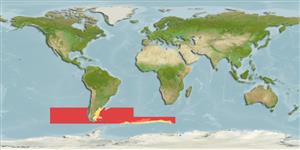Issue
This species is synonym of Bathylagus antarcticus Günther, 1878 in Eschmeyer (CofF ver. May 2011: Ref. 86870) following Kobyliansky (2006: Ref. 57776). The species page will be removed.
Environment: milieu / climate zone / depth range / distribution range
पारिस्थितिकी
समुद्री बैथीपिलाजिक; गहराई सीमा 0 - 2800 m (Ref. 58018). Deep-water; 39°S - 58°S
Southern Ocean: Scotia Sea. Also known from the southwest Atlantic and southeast Pacific.
आकार / वज़न / Age
Maturity: Lm ? range ? - ? cm
Max length : 21.7 cm SL पुल्लिंग / अलिंग; (Ref. 5002)
Life cycle and mating behavior
Maturities | पुनरुत्पत्ति | Spawnings | Egg(s) | Fecundities | लार्वा
Gon, O., 1990. Bathylagidae. p. 107-110. In O. Gon and P.C. Heemstra (eds.) Fishes of the Southern Ocean. J.L.B. Smith Institute of Ichthyology, Grahamstown, South Africa. 462 p. (Ref. 5002)
IUCN Red List Status (Ref. 130435)
Threat to humans
Harmless
Human uses
मात्स्यिकी: कोई रुचि बग़ैर
साधन
Special reports
Download XML
इंटरनेट स्रोत
Estimates based on models
Preferred temperature (Ref.
123201): 1.9 - 4.8, mean 3.1 °C (based on 108 cells).
Phylogenetic diversity index (Ref.
82804): PD
50 = 0.5078 [Uniqueness, from 0.5 = low to 2.0 = high].
Bayesian length-weight: a=0.00513 (0.00205 - 0.01282), b=3.00 (2.79 - 3.21), in cm total length, based on LWR estimates for this (Sub)family-body shape (Ref.
93245).
Trophic level (Ref.
69278): 3.2 ±0.39 se; based on food items.
लौटाव (Ref.
120179): माध्यम, न्यूनतम जनसंख्या दुगनी होने का समय 1.4 - 4.4 वर्ष। (Preliminary K or Fecundity.).
Fishing Vulnerability (Ref.
59153): Low vulnerability (16 of 100).
